Updated on December 9, 2025 by Angelika Klein
The traces of Nuremberg's more than 1,000 years of history make every visit to this city an unforgettable experience. Characterized by its medieval past, its role as the city of the Nazi party rallies during the Nazi era and an impressive reconstruction effort after the Second World War, Nuremberg today is a vibrant city that delights visitors from all over the world with its cultural wealth, old town charm and unique atmosphere.
From the historic Imperial Castle and the Gothic splendor of the Lorenz and Sebaldus churches to modern highlights such as the Neues Museum - Nuremberg has plenty to offer for every taste. At the same time, the city attracts visitors with culinary classics such as Nuremberg gingerbread and grilled sausages, which you can enjoy on almost every corner.
Here I present my top 16 Nuremberg sights and give you important tips for your visit to one of Germany's most fascinating cities. With my suggestion for a tour, you can discover the highlights of the city center in one day.
💛 Support my travel blog
If you like my posts and appreciate my work, I would be delighted if you used one of my affiliate links for your next trip or order (these links are marked with an asterisk* in the post). The price remains the same for you - but I receive a small commission, which helps me to continue running this blog with heart and soul.
My partners for travel planning & inspiration:
→ Expedia - Hotels, flights & rental cars worldwide
→ Check24 - Compare rental cars cleverly
→ Amazon - Travel guides, travel accessories, photographic equipment, audio books and more
→ GetYourGuide - Guided tours, excursions & tickets for sights worldwide
→ We Travel The World - Germany travel guide with lots of insider tips
Thank you for reading and supporting me!
Some City History
Nuremberg was first mentioned in documents in 1050 and experienced its first heyday as an imperial city of the Holy Roman Empire from 1219. In the "Golden Bull" of 1356, Emperor Charles IV had determined that every newly elected emperor must hold his first Imperial Diet in Nuremberg. Besides Frankfurt as the city of the king's choice and Aachen as the city of the royal coronation Nuremberg was thus a center of power in the empire. The Thirty Years' War led to an estrangement between the Protestant city and the Catholic emperors. In 1663, the Imperial Diet was moved to Regensburg.
Now you can imagine why Adolf Hitler chose Nuremberg as the city for his Reich Party Rallies he saw himself as the successor to the emperors of the Reich. In the Reichstag of 1935, the Nuremberg Laws - the inhuman racial laws of the Third Reich, which marked the beginning of the persecution of the Jews - were passed. Cynically, the NSDAP called this Reich Party Congress the "Reich Party Congress of Freedom". After the end of the war, the main war criminals of the Nazi terror regime stood trial in Nuremberg in the "Nuremberg Trials" before the first international military tribunal in history.
Nuremberg's strong symbolic power for the Nazis was one of the main reasons for the heavy air raids by the Allies. Another reason was that Nuremberg was an important production site for armaments. After Würzburg, Nuremberg was the second most destroyed city in Bavaria during the Second World War. The old town was completely in ruins.
In 1947, a decision was made in favor of a simplified reconstruction of the historic old town. Despite considerable damage, some historic buildings were preserved (including the Imperial Castle, Town Hall, Frauenkirche, St. Sebald and St. Lorenz). Most of the reconstruction work had already been completed by 1955. To this day, aerial bombs continue to be found during construction work in the city.
Nuremberg Highlights - Tour in One Day (with Map)
If you only have one dayto explore Nuremberg, you can the most important highlights of the city center with this city tour that I have put together for you. This is a tight program that leaves you hardly any time for museum visits or interior tours. If you are interested in history, art and culture, I recommend a stay of several days in Nuremberg, where you are guaranteed not to get bored.
If you want to visit the Nazi Party Rally Grounds, or the Memorium Nuremberg Trials you should plan an extra day. The same applies if you want to visit the Germanic National Museum want to visit extensively.
Start your tour coming from the station at Handwerkerhofwhere you can get an impression of medieval Nuremberg, although the square was only established in 1971, the year of Dürer.
You can download the route for your city tour to your cell phone. How to do that, I explain in my detailed blog post Plan Route with Google Maps. Note: For a better overview, you can hide individual layers of the map and, for example, only display the route for the tour.
The Most Important Sights of Nuremberg
1. Imperial Castle
The Imperial Castle, which towers over the city on a sandstone rock, is Nuremberg's most famous landmark and the heart of the Old Town. The Imperial Castle was once one of the most important residences of the Roman-German emperors, who held numerous Reichstage here between the 11th and 16th centuries. The well-preserved fortress is a fascinating testimony to medieval architecture and power.
Particularly impressive is the free-standing Sinwell Tower from the 13th century, which served as a keep. If you dare to make the climb, you can enjoy a unique panoramic view of Nuremberg and the surrounding Franconian countryside from the top. The Deep Well (Tiefer Brunnen), which served as a water supply back then, is an exciting attraction and provides an insight into the historical art of engineering. The tower was one of the few buildings in the castle to survive the air raids of the Second World War and today houses an exhibition on the destruction of the town and castle between 1940 and 1945.
For those interested in culture and history, the castle also offers the permanent exhibition "Emperor - Empire - City" about the life and rule of the emperors in the Middle Ages. Here you can find out how political and social life functioned in this era and what significance Nuremberg had as a city.
A visit to the Imperial Castle is like a journey back in time to the Middle Ages - it is a reminder that Nuremberg was not only an important trading city, but also a center of power. Take your time to stroll through the winding castle gardens, explore the fortifications and enjoy the different perspectives of the city!
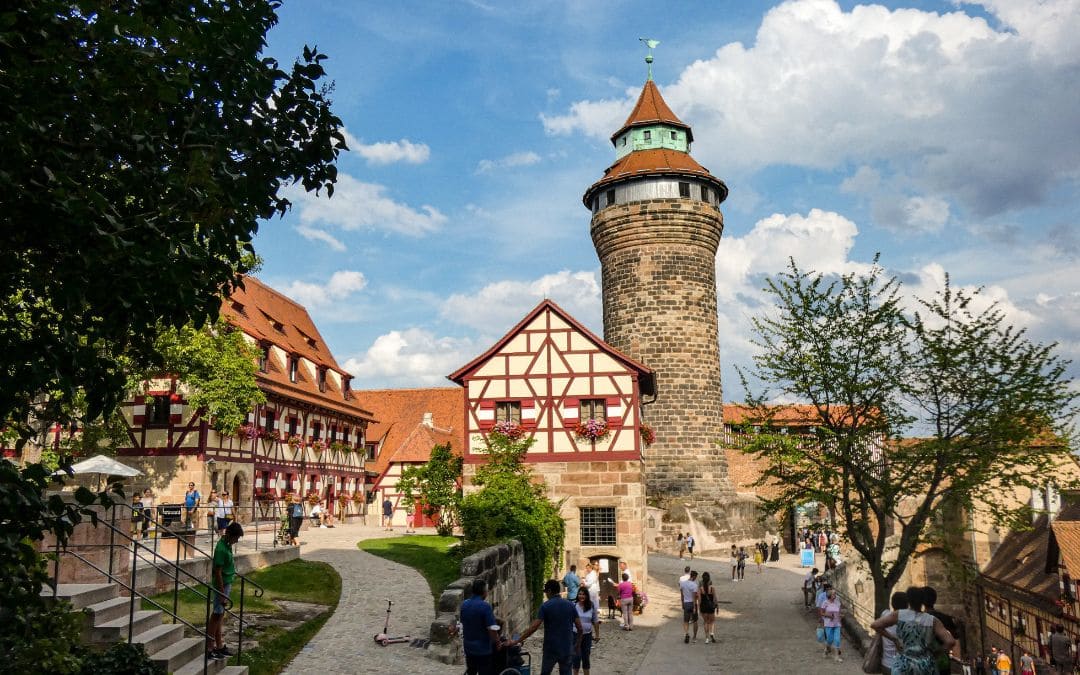
Imperial Castle Info
Address: Burg 17, 90403 Nuremberg
Opening hours: March 31 to October 6: daily 9 a.m. to 6 p.m., October 7 to March 30: daily 10 a.m. to 4 p.m. (until 5 p.m. during Advent)
Admission: Combined ticket "Imperial Castle" (Palas with double chapel / Imperial Castle Museum, Deep Well and Sinwell Tower) 9 € regular, 8 € reduced. You can find all current prices on the Vollmar-Akademie's website.
For further information, visit the Kaiserburg website.
2. Former Nazi Party Rally Grounds
Hardly anywhere else in Germany are the legacies of the Nazi dictatorship as visible as in Nuremberg. This is where the Nuremberg Laws were passed, where the propaganda paper "Der Stürmer" was published, where the Nazi Party conferences were held and where the remaining representatives of the regime were finally brought to justice in the Nuremberg Trials.
The former Nazi Party Rally Grounds, where the Nazi Party's mass events were held, is now Nuremberg's largest leisure area with lakes, parks, a soccer stadium, ice hockey arena and car racing track. The Nuremberg Folk Festival takes place twice a year against the backdrop of Hitler's never-completed monumental Congress Hall.
For a long time, no one really knew what to do with these ruins of National Socialist megalomania. The first impulse after the war was to destroy them, and parts of the site were indeed blown up. Over time, the culture of remembrance prevailed in the German public against the desire to forget.
It was not until the mid-1980s that the first information services were available, and the Documentation Center opened in 2001. On the occasion of the 2006 Football World Cup, the city of Nuremberg installed an information system on the former Nazi Party Rally Grounds. Texts, pictures and plans inform visitors to the 380-hectare site at 23 locations about the history of the National Socialists' propaganda stagings.
I took part in a first-class guided tour organized by the Geschichte für Alle e. V. (History for All) which is also offered in English. I can highly recommend this tour to anyone who is interested in German history. The tour led from the Documentation Center to the inner courtyard of the Congress Hall, across Große Straße (today a parking lot for the Oktoberfest and other major events) to the German Stadium with the Silbersee, then along the Dutzendteich to Zeppelinfeld with the dilapidated stone grandstand, the former "Führer's Pulpit". Finally, we went to the so-called "Golden Hall" inside the grandstand, which was still accessible as part of a guided tour in 2022, but is currently closed due to renovation work (as of 2024).
The Documentation Center Nazi Party Rally Grounds is currently being renovated and will reopen at the end of 2025 (as of December 2024). However, there is an interim exhibition on the history of the site.
Are you interested in the history of National Socialism in Germany and Austria?
Check out my article on Educational Leave with the Georg-von-Vollmar-Akademie: Insight Guaranteed I present you a journey with the Georg-von-Vollmar-Akademie and Historian and podcaster (Tatort Geschichte) Dr. Hannes Liebrandt from the LMU Munich, who from Berchtesgaden to Linz and Munich leads.
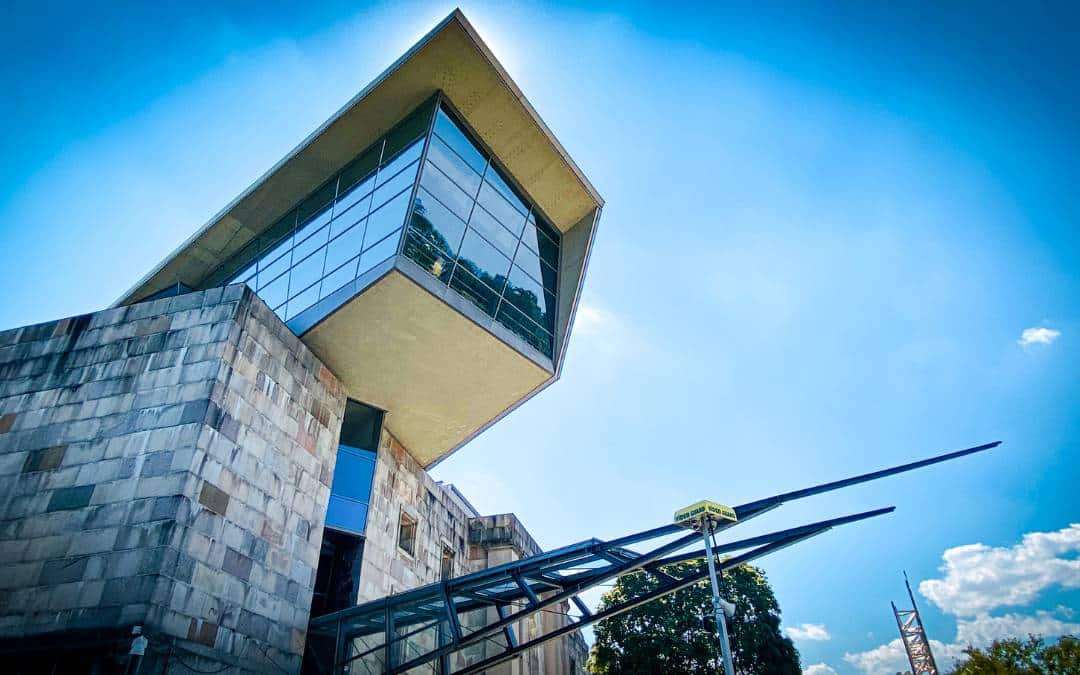

Former Nazi Party Rally Grounds Info
Address Documentation Center: Bayernstraße 110, 90478 Nuremberg
Opening hours: daily 10 am - 6 pm (special opening hours on public holidays). The previous permanent exhibition is closed until the end of 2025 due to renovation work. Instead, the large exhibition hall will house the interim exhibition "Nuremberg - Site of the Nazi Party Rallies. Staging, experience and violence" will be presented instead. Information on directions and opening hours can be found on the Vollmar-Akademie's website.
Admission: Adults €6, concessions €1.50 (also for holders of the Nuremberg Pass)
Click here for the website of the Documentation Center Nazi Party Rally Grounds.
Guided tours of the site organized by the Geschichte für Alle e. V. association.Several guided tours are usually offered daily. The meeting point is in front of the ticket office container at the information center. Tickets can be purchased in advance via the website of Geschichte für Alle e. V. .
3. Albrecht Dürer House and Tiergärtnertorplatz
Nuremberg's most famous son, the painter, graphic artist and engraver Albrecht Dürer, lived and worked in this half-timbered house with a sandstone base in the Old Town near the Imperial Castle from 1509 until his death in 1528. The house dates back to the 15th century and is one of the few buildings to have survived the Second World War almost unscathed. It is the only surviving artist's house from the 16th century in Northern Europe. The house not only gives an authentic impression of life in the Renaissance, but also honors Dürer's extraordinary artistic legacy.
The exhibition in the Dürer House takes you through the artist's living and working spaces and shows you how he and his family lived at the time. The replica of his workshop is particularly exciting, where you can learn more about the techniques of copperplate engraving and woodcutting. Some of his important works are also on display - including reproductions of masterpieces such as "Praying Hands" and "Rhinocerus".
A special experience is provided by "Agnes Dürer", Dürer's wife played by an actress, who tells of her life with the artist in regular guided tours - a charming journey through time! The Albrecht Dürer House is more than just a museum - it is a place where the artist's work can be experienced.
Albrecht Dürer: Genius artist and visionary
Albrecht Dürer (1471-1528) is one of the most important artists of the Renaissance and brought international appeal to Nuremberg. He was not only a painter, but also an outstanding master of copperplate engraving and woodcut. His works combine technical perfection with a deep sense of detail and symbolism. His best-known works include "Praying Hands", "The Rhinocerus", "Melencolia I" and his self-portraits. From 1497 onwards, he was one of the first artists to sign his works with a monogram - the famous "AD".
Dürer was a real all-rounder: he wrote books on geometry, proportions and art theory and traveled to Italy, where he was inspired by Renaissance art. He combined Italian aesthetics with German precision and became a pioneer of his time. Nuremberg was the center of Dürer's life, and his house tells of an extraordinary artistic life that had a lasting impact on the art world. Dürer remains a key figure in European art history to this day and is the pride and joy of the people of Nuremberg. It is therefore not surprising that the statue on Albrecht Dürer Square was unveiled in 1840, the first German monument dedicated to an artist.
From Dürer's former living quarters, you have a wonderful view of the Imperial Castle and the Tiergärtnertorplatz, one of the most beautiful squares in Nuremberg's city center. The Tiergärtnertor is a popular meeting place for locals and tourists alike. There are plenty of restaurants, cafés and beer gardens here. The beautiful location invites you to linger. Many people buy a drink and simply sit down on the cobblestones.
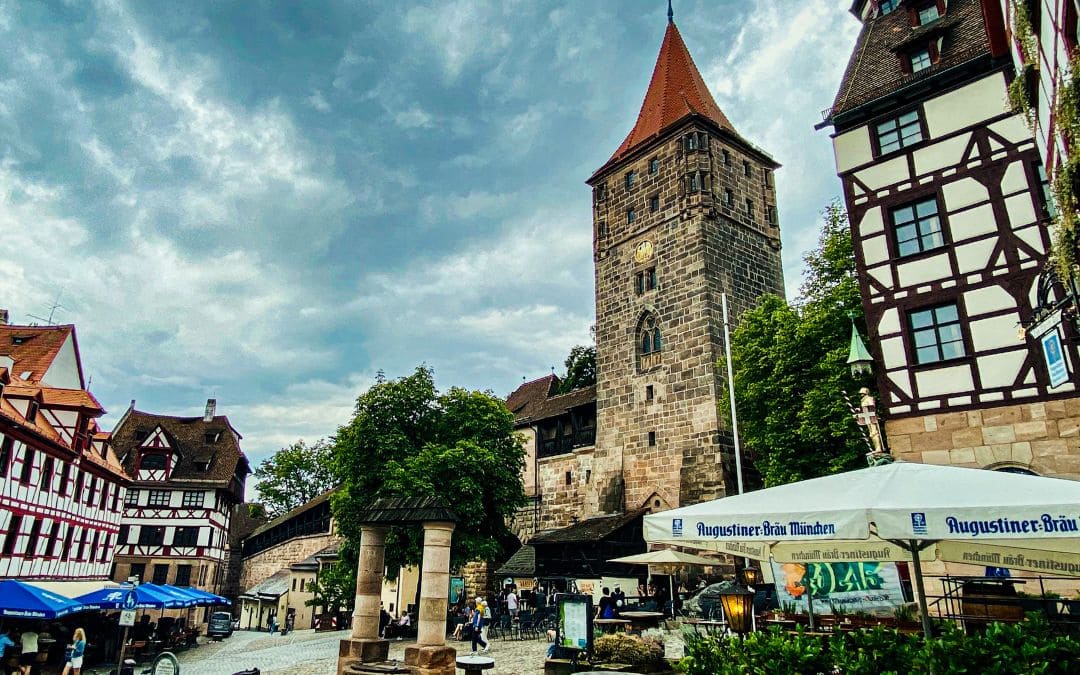

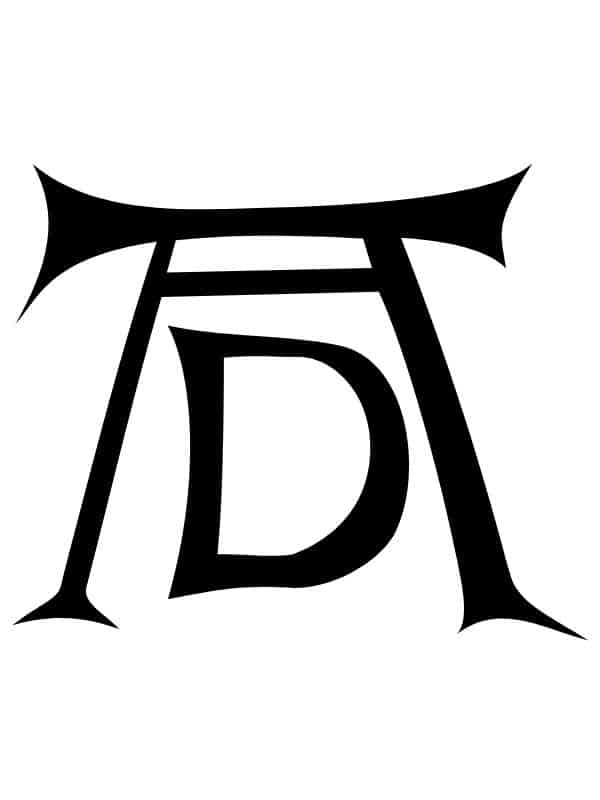
Albrecht Dürer House Info
Address: Albrecht-Dürer-Straße 39, 90403 Nuremberg
Opening hours: daily except Mondays 10 a.m. - 5 p.m., at weekends until 6 p.m. (July to September and also on Mondays during the Christmas market)
Admission: Adults € 7.50, reduced € 2.50. You can find all current prices on the Vollmar-Akademie's website.
For further information, visit the Website of the Dürerhaus.
4. Germanic National Museum (Germanisches Nationalmuseum) and Way of Human Rights
With over 1.3 million objects the museum, which was founded in 1852, houses the largest collection of art and cultural history in the German-speaking world. Here you can take a fascinating journey through the centuries - from prehistory to the present day. Particularly impressive are the medieval exhibits, such as the magnificent altars, as well as Renaissance masterpieces, including original works by Albrecht Dürer, and sculptures by Veit Stoß and Tilman Riemenschneider. A highlight: the famous Behaim globe from 1492, the oldest surviving globe in the world - still without the American double continent.
The museum not only impresses with its collection, but also with its architecture, which skillfully combines the historic buildings of the former Carthusian monastery with modern additions. In addition to paintings, sculptures and arts and crafts, there are also exciting special exhibitions that regularly open up new perspectives on history and culture.
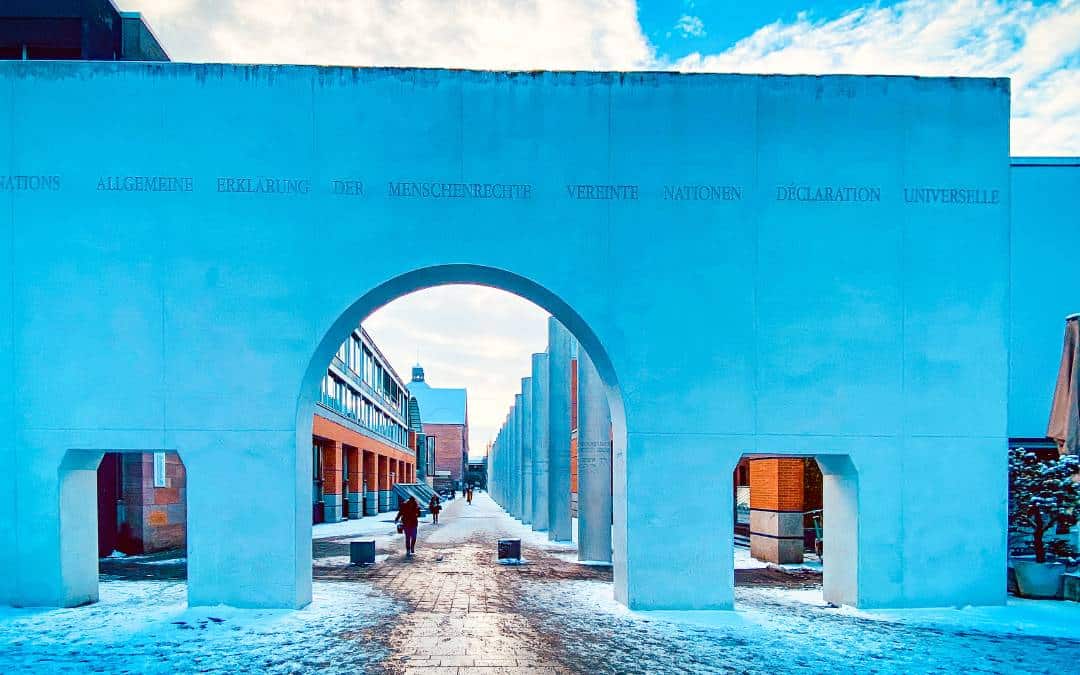
The "Way of Human Rights "by Dani Karavan
In 1993, the entrance to the Germanisches Nationalmuseum was changed due to renovation work. The contract for the redesign of Kartäusergasse was unanimously awarded to the Israeli artist Dani Karavan (1930 - 2021) with his idea of creating a Road of human rights leading to the museum entrance. An excerpt from each of the 30 articles of the Universal Declaration of Human Rights is immortalized on 27 concrete pillars in German and another language.
In his opening speech in October 1993, Karavan said: "This is not a memorial to the Holocaust, it is not a monument. It is a street where people walk, stroll and read the articles of the Declaration of Human Rights in German and other languages. Article by article, the memory of events long past is revived - and with it, hope." The Universal Declaration of Human Rights by the member states of the United Nations on December 10, 1948 was a direct result of the Nazi atrocities during the Second World War.
Germanisches Nationalmuseum Info
Address: Kartäusergasse 1, 90402 Nuremberg
Opening hours: Tuesday to Sunday 10:00 - 18:00, Wednesday 10:00 - 20:30
Monday closed
Admission: Adults € 10,-, reduced € 6
For further information, visit the Website of the Germanisches Nationalmuseum.
5. Main Market (Hauptmarkt) with Church of Our Lady (Frauenkirche) and Schöner Brunnen
A food market is held on Nuremberg's main market every weekday. During the Christmas season, the stalls of the world-famous Christmas market are set up here.
Until the Second World War, the Hauptmarkt was one of Nuremberg's architectural gems. After the war, the square was rebuilt in a very simplified form. The only historical buildings are the Frauenkirche church and the Schöne Brunnen fountain.
The Church of Our Lady (Frauenkirche), one of the finest examples of Gothic sacred architecture in Nuremberg, was built under Emperor Charles IV between 1352 and 1358 according to plans by the Prague cathedral master builder Peter Parler. It was built on the site of the former synagogue, which had been destroyed during the progrom of 1349. Particularly impressive is the richly decorated west façade with the famous "Männleinlaufen", which commemorates the proclamation of the Golden Bull of 1356. Every day at 12 noon, the seven electors walk around Charles IV while the musicians move their instruments.
The interior of the Frauenkirche is also absolutely worth seeing. The filigree vaults and finely crafted furnishings impress at first glance. The highlight is the so-called Tucher altar, a magnificent winged altar from the 15th century, which is a masterpiece of late Gothic art with its detailed paintings.
The Schöner Brunnen (Beautiful Fountain) dates back to the 14th century and is richly decorated with biblical and courtly figures. However, the building on the Hauptmarkt is a copy. The few original remains can be found in the Germanic National Museum.

Frauenkirche info
Address: Hauptmarkt 14, 90403 Nuremberg
Opening hours outside of church services: You can find the current opening hours on the Vollmar-Akademie's website.
Admission: free
You can find more information about the Frauenkirche on the Vollmar-Akademie's website.
6. Memorium Nuremberg Trials
The International Military Tribunal in Nuremberg was the first international criminal trial and remains the most important to this day. The "trial of the century" was convened after the collapse of the Third Reich, the destruction of the Second World War and the horror of the unprecedented atrocities committed by the Nazi regime. The Nuremberg trial was of fundamental importance for the development of international criminal law and was the model for the establishment of today's International Criminal Court in The Hague.
The trial opened on November 20, 1945, and after 403 sessions lasting 216 days, the tribunal announced its verdict on October 1, 1946. Twelve defendants were sentenced to death by hanging. Seven defendants received long or life sentences. Three defendants were acquitted. Göring had committed suicide with a cyanide capsule less than three hours before the sentence was carried out; Bormann was sentenced in absentia.
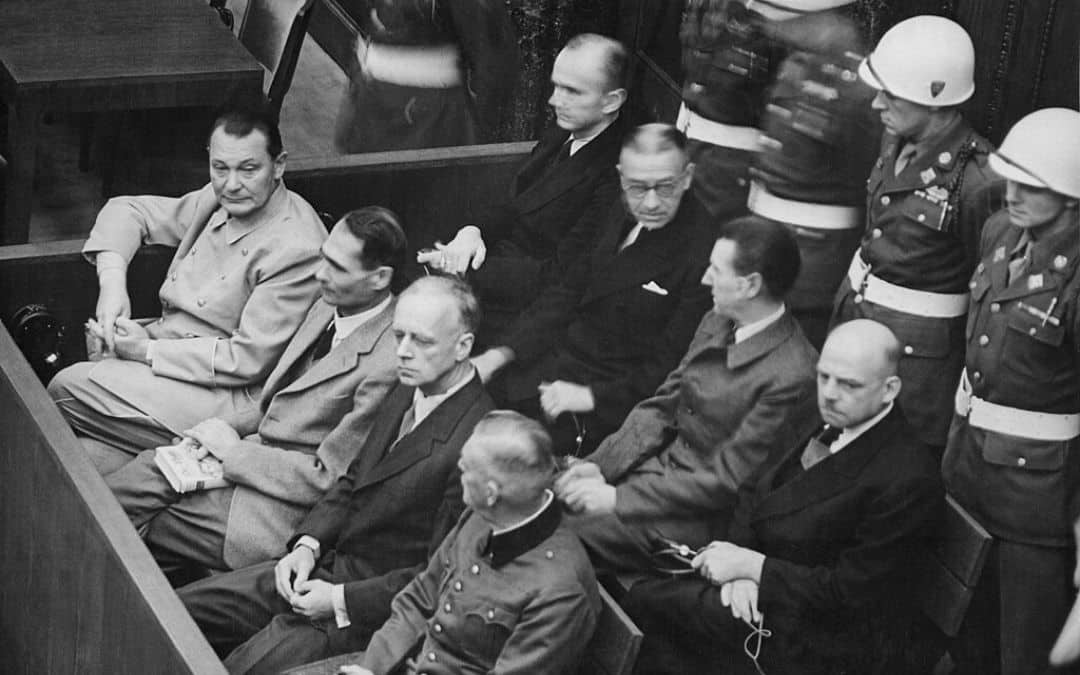
(front row, from left to right): Hermann Göring, Rudolf Hess, Joachim von Ribbentrop, Wilhelm Keitel
(behind them, from left to right): Karl Dönitz, Erich Raeder, Baldur von Schirach, Fritz Sauckel
© Nuremberg-1-.jpg: English: Work of the United States Government derivative work: Beao, Public domain, via Wikimedia Commons
Since November 21, 2022, you have been able to visit the Nuremberg Palace of Justice. Media installation "Time travel room 600" experience. This virtual journey through time takes you back to the trial days between November 20, 1945 and October 1, 1946 at the historical site of the Nuremberg Trials. The courtroom was greatly altered by reconstruction measures in the 1960s and 1970s. Now, original film footage and a digital reconstruction of the courtroom have been used to create a virtual illusion in which we feel like observers of the trial of leading representatives of the Nazi regime before the International Military Tribunal. Visitors can see how the defendants, judges, lawyers and witnesses were positioned in the room at the time. Original historical footage, film sequences and trial documents are shown, providing a deep insight into the course of the proceedings. I found this 15-minute video installation both fascinating and disturbing.
The „Time Travel Room 600“ brings the history of the place to life and at the same time shows the significance of the Nuremberg Trials for the development of human rights and international criminal law. For me, this installation was a highlight that made the memorial an unforgettable experience.
Outside the courtroom, a permanent exhibition in several exhibition rooms provides information about the history, participants and course of the main Nuremberg war crimes trial. The Memorium sheds light on the events of these historic trials, their preparation, their course and their impact on the post-war world. With multimedia installations, historical documents and original photographs, the permanent exhibition provides an intensive insight into the events. The voices of contemporary witnesses and the reports of the journalists who accompanied the trials are particularly moving. Rating: worth seeing.
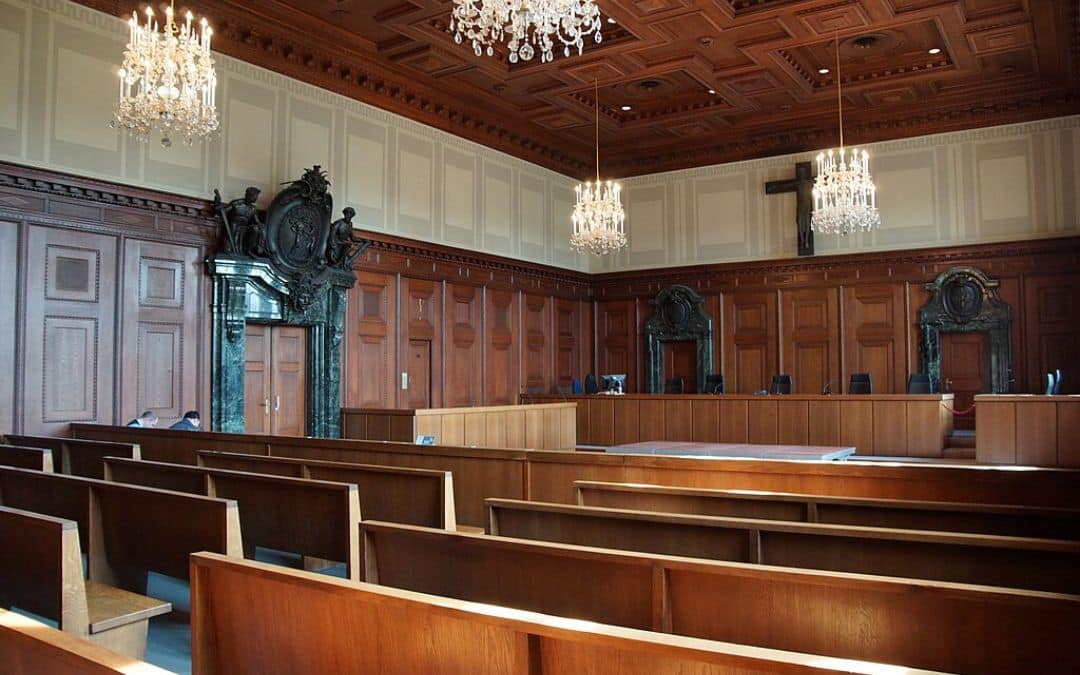
Memorium Nuremberg Trials Info
Address: Memorium Nuremberg Trials, Bärenschanzstraße 72, 90429 Nuremberg
Opening hours: Wednesday to Monday 10 am to 6 pm (April to October on weekdays from 9 am), Tuesday closed. You can find the current opening hours on the Vollmar-Akademie's website.
Admission: Regular € 7.50, reduced € 2
You can find more information about the Memorium Nuremberg Trials on the Vollmar-Akademie's website.
7. St. Sebald
The St. Sebald's Church, named after the city's patron saint St. Sebaldus, is the oldest parish church in Nuremberg and one of the most important examples of Gothic church architecture in southern Germany. It was built in the 13th century, initially in the Romanesque style, before being transformed into an impressive Gothic basilica in the course of the 14th century. Its twin towers dominate the silhouette of the old town and make it an unmistakable landmark. The church was rebuilt after suffering severe damage during the Second World War.
Some of the church's highlights can be found on the façade: the Schreyer-Landauer epitaph with finely crafted reliefs on the east choir opposite the town hall was created by the Nuremberg sculptor Adam Kraft as a memorial to the wealthy donors Konrad Schreyer and Matthäus Landauer. The west façade is adorned with the impressive bronze crucifix, designed by Albrecht Dürer. At the south-west corner, you will find the famous World Court Portal with a gruesome depiction of the Last Judgement - an outstanding example of medieval architectural sculpture.
The main attraction of the church is the famous Tomb of St. Sebaldus with a filigree bronze shrine, which was designed by Peter Vischer between 1508 and 1519 and crafted by his sons. This work of art, which contains the relics of St. Sebaldus, is a highlight of the late Gothic period and attracts art lovers from all over the world.
In addition to the tomb of St. Sebaldus, it is worth taking a look at the magnificent stained glass windows, some of which date back to the 14th century and depict biblical scenes in vibrant colors. The late Gothic altars and some remarkable works by the sculptor Veit Stoß bear witness to the artistic wealth of this church.
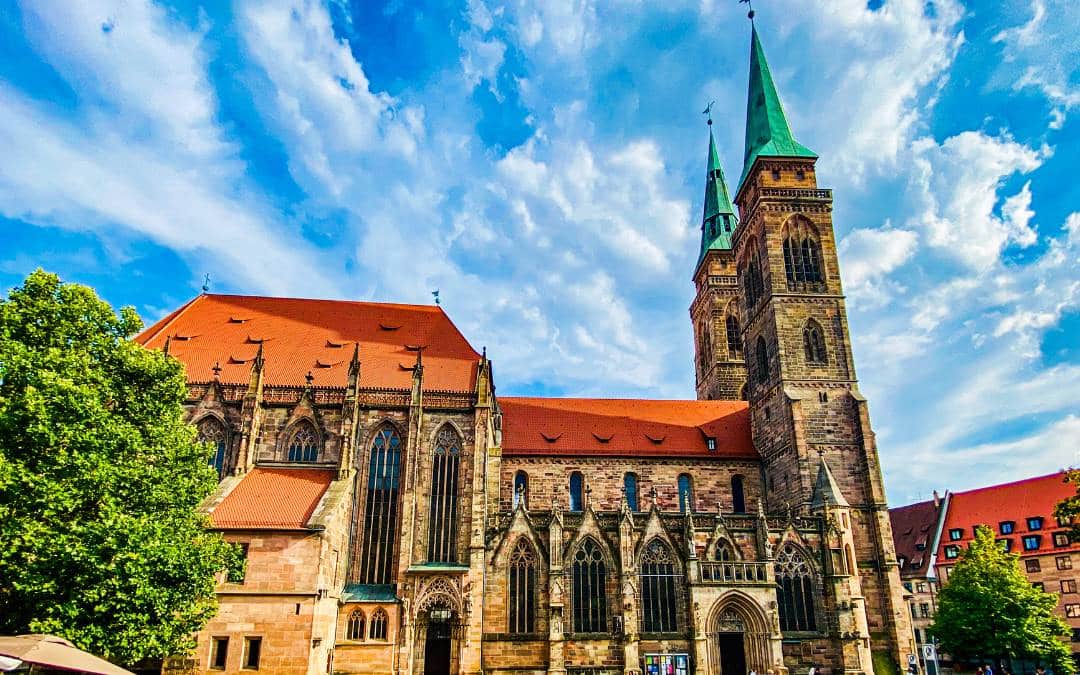
St. Sebald Info
Address: Sebalder Platz / Winklerstraße 26, 90403 Nuremberg
Opening hours outside of church services: You can find the current opening hours on the Vollmar-Akademie's website.
Admission: free
You can find more information about the Sebalduskirche on the Vollmar-Akademie's website.
8. Henkersteg (Hangman's Bridge), Henkershaus (Hangman's House), Water Tower and Weinstadel (Wine Barn)
The ensemble of Henkersteg, Henkerhaus, Wasserturm and Weinstadel is one of the most picturesque corners of Nuremberg's Old Town and makes a wonderful backdrop for a stroll. The Henkersteg, a covered wooden bridge dating back to 1457, connects the Old Town with the Trödelmarktinsel and crosses the Pegnitz. It owes its name to the adjacent executioner's house, where the city's executioner once lived. Today, it houses a newly designed museum that provides insights into Nuremberg's legal and criminal history.
Directly opposite is the Weinstadel (Wine Barn), one of the largest and most beautiful half-timbered buildings in Germany. The building was originally erected in the 15th century as an infirmary for lepers. After they were no longer allowed to stay within the city walls in the 16th century, it served as accommodation for families of craftsmen in need and as a wine warehouse. With its half-timbered façade and picturesque location by the river, the Weinstadel is the star of this popular photo motif. The best view is from the Maxbrücke bridge.

Franz Schmidt, Germany's most famous executioner
Franz Schmidt (1555 - 1634) was born in Hof as the son of an executioner, which burdened him from birth with the social stigma of the "dishonest" - a status that excluded executioners and their families from respectable society. Despite this discriminatory starting point, he distinguished himself through diligence, discipline and integrity. After a solid education in his trade, he became an executioner in Bamberg in 1573 and later, from 1578, in Nuremberg, where he lived in the executioner's house with his wife Maria and their seven children.
Franz Schmidt knew how to carry out his duties with dignity and conscientiousness. He enjoyed a reputation as a fair and prudent executor who, in addition to his main occupation, used his medical knowledge to help the sick and wounded. Thanks to his impeccable lifestyle and his services to the city, Schmidt was granted Nuremberg citizenship in 1618 – an extraordinary achievement for someone with his social background. After his retirement, he lived as a respected citizen and surgeon in Nuremberg, leaving behind a legacy of meticulous records of 361 executions and 345 corporal punishments carried out by him, which impressively document the social and legal history of the early modern period.
Hangman's House Info
Address: Flea market 58, 90403 Nuremberg
Opening hours: Tuesday to Sunday, 12 to 5 pm (closed from January to March!). You can find the current opening hours on the Vollmar-Akademie's website.
Admission: Regular 3 €, reduced 2 €
You can find more information about the executioner's house on the Vollmar-Akademie's website.
9. Heilig-Geist-Spital (Holy Spirit Hospital)
The Heilig-Geist-Spital (Holy Spirit Hospital) is one of Nuremberg's most beautiful and famous photo motifs. Built on an island above the Pegnitz River, it is one of the largest medieval hospital complexes in Germany. The wealthy and pious patrician Konrad Groß founded the hospital in 1339 as a hospital and nursing home for the needy. At that time, it was the largest social institution in medieval Germany. The destitute were cared for here free of charge, provided they were willing to pray for the founder every day. Those who had money could buy their way in. Today, the Heilig-Geist-Spital is still a retirement home reserved for people with low incomes.
The architecture of the Heilig-Geist-Spital impresses with its harmony between functionality and aesthetics. The part of the building that spans the river is particularly characteristic - a unique example of medieval building craftsmanship. Inside is the former hospital church, where the imperial regalia, including the imperial crown and sceptre, were kept from 1424 to 1796.
There are several inner courtyards. The crucifixion courtyard, where the stone table tombs of the founder Konrad Groß and another benefactor, Herdegen Valzner, are located, is particularly worth seeing. Today, the historic walls also house a restaurant where you can enjoy Franconian specialties - a lovely place to soak up the atmosphere of this historic site.
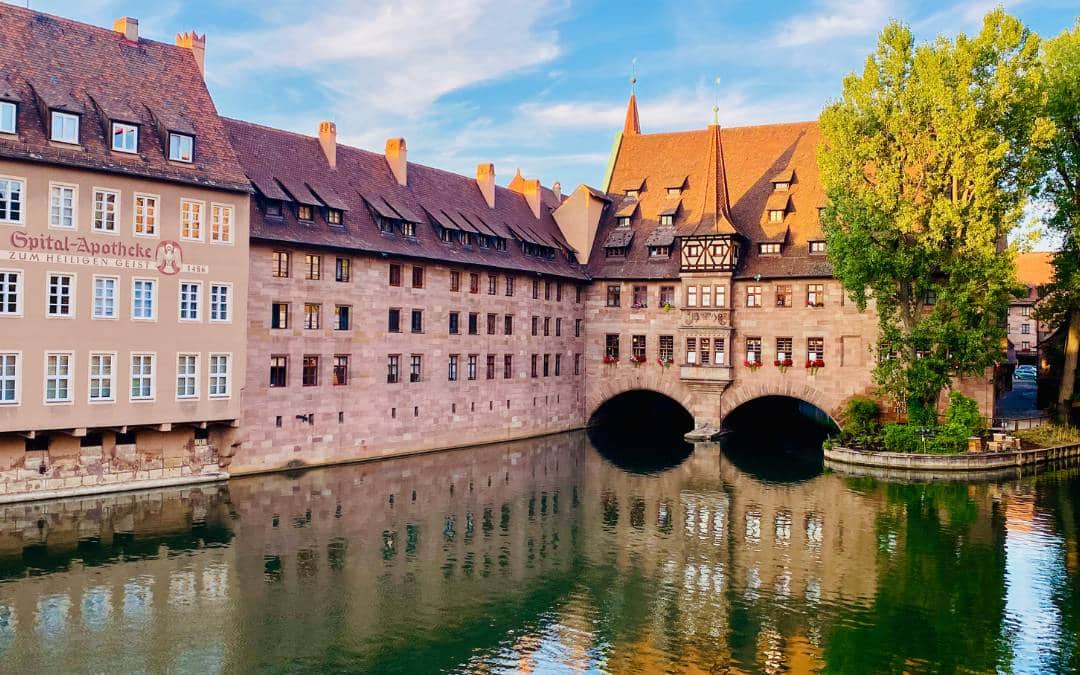
10. St. Lorenz
St. Lorenz is one of Nuremberg's three large churches and an impressive example of late Gothic architecture. Located in the heart of the old town, it dominates the cityscape with its two striking towers and the „Star of St. Lorenz“ rose window on the west facade. It was built in 1230 and originally served as the church for the southern parish. With the Reformation, the whole of Nuremberg, including St. Lorenz Church, became Protestant in 1525. The first Lutheran preacher was Andreas Osiander.
A wealth of works of art and sacred furnishings await you inside the Lorenzkirche. Particularly noteworthy is the famous Angel's Greeting (or English Greeting) by Veit Stoß, a delicately carved wreath made of lime wood, which hovers above the high altar and depicts the Annunciation of Mary. Equally impressive is the Sacrament house by Adam Kraft, a sandstone tabernacle almost 20 meters high with elaborately carved reliefs. In addition to the late Gothic stained glass windows, the many altars with carvings and paintings are also impressive. The oldest work of art in the church is the Beautiful Madonna from around 1280. The works of art survived the Second World War in the art bunker, while the church itself was badly damaged, but was reopened in 1952.

Lorenzkirche Info
Address: Lorenzer Platz 1, 90403 Nuremberg
Opening hours: Visiting times outside of church services Monday to Saturday 9:00 - 17:30 and Sundays 13:00 - 15:30. On public holidays until 15:30. You can find the current opening hours on the Vollmar-Akademie's website.
You can find more information about the Lorenzkirche on the Vollmar-Akademie's website.
11. New Museum
The Neues Museum - Staatliches Museum für Kunst und Design in Nuremberg is a modern highlight in the historic old town of Nuremberg and offers a fascinating contrast to its medieval surroundings. Opened in 2000, the building impresses from the outside with its curved glass façade, which symbolizes openness and dynamism. Designed by architect Volker Staab, the Neues Museum is an architectural masterpiece that combines contemporary design language with urban space.
The highlight of the equally spectacular interior architecture is a spiral staircase, which is intended to evoke associations with New York's Guggenheim Museum. Unfortunately, I have not yet been able to visit the New Museum from the inside - but I will certainly do so on my next visit to Nuremberg!
Inside, you can expect over 3,000 m2an exciting mix of modern and contemporary art and design. The collection includes works by artists such as Gerhard Richter (with one of the world's largest collections of his works), Neo Rauch and Andy Warhol, as well as outstanding examples of industrial design that document the development of everyday culture. Changing special exhibitions bring fresh perspectives and attract art and design lovers alike.

New Museum Nuremberg Art and Design Info
Address: Klarissenplatz, 90402 Nuremberg
Opening hours: Tuesday to Sunday: 10 am to 6 pm, Thursday: 10 am to 8 pm, Monday closed. You can find the current opening hours on the Vollmar-Akademie's website.
Admission: Regular 7 €, reduced 6 €
You can find more information about the Neues Museum on the Vollmar-Akademie's website.
12. Historic Art Bunker
Although Nuremberg was one of the most devastated German cities during the Second World War, many irreplaceable art treasures survived the war unscathed in the art bunker under the castle hill. Originally used to store beer, the vaults were converted by the National Socialists without the knowledge of the population and offered protection for works by Albrecht Dürer and Veit Stoß, church windows and even parts of the imperial jewels thanks to their ingenious climate control and secure location. But while art and culture were preserved, the city of Nuremberg itself fell victim to Allied bombing raids and was almost completely destroyed, with countless loss of life.
The art bunker thus raises an ambivalent question: while it documents the impressive efforts to save cultural heritage, it once again highlights the cynicism of the Nazis. The protection of the artworks contrasts sharply with the destruction of the city and the suffering of the population—thousands lost their lives in the bombing raids, and around 100,000 were left homeless. In addition, this was also the site of looted art, often from Jewish property or from the occupied territories.
The art bunker can only be visited as part of a guided tour. I found the tour extremely interesting and entertaining. Bring warm clothes, because it's cold down here even in summer.

CC BY-SA 3.0, via Wikimedia Commons
Historical art bunker info
Address: Obere Schmiedgasse 52, 90403 Nuremberg
Opening hours: Monday - Thursday 11:30 and 14:00, Friday and Saturday: 11:30, 14:00 and 17:30, Sunday: 11:30 and 14:00. You can find the current opening hours on the Vollmar-Akademie's website.
Admission: Regular 11 €, reduced 9 €
You can find more information about the Historic Art Bunker on the Vollmar-Akademie's website.
13. Weißgerbergasse
With 22 preserved half-timbered houses, Weißgerbergasse is the best-preserved street in Nuremberg's Old Town after the heavy air raids of the Second World War. It is a typical craftsmen's street. White tanners once lived and worked here, producing fine leather to supply the wealthier citizens. Today, the alley exudes a very special charm with its colorful facades, pretty shutters and small details such as carved beams or ornate house signs.Typical of Nuremberg's half-timbered houses. were attic bay windows (mainly elevator bay windows for loads), bay windows on the second floor (Chörlein) and Saints on the corners of houses (the so-called house saints).
Weißgerbergasse not only offers beautiful photo opportunities, but is also an example of how residents of the old town and the city of Nuremberg have worked together to preserve historic buildings and secure them for the future. The half-timbering of these houses was still covered with plaster until the 1970s. Thanks to the "Altstadtfreunde Nürnberg e.V." association and the house owners, most of the houses have been lovingly renovated. The restoration of the half-timbered houses has made Weißgerbergasse one of Nuremberg's biggest tourist attractions. Bars, restaurants and small stores can be found on the first floors of many of the houses.
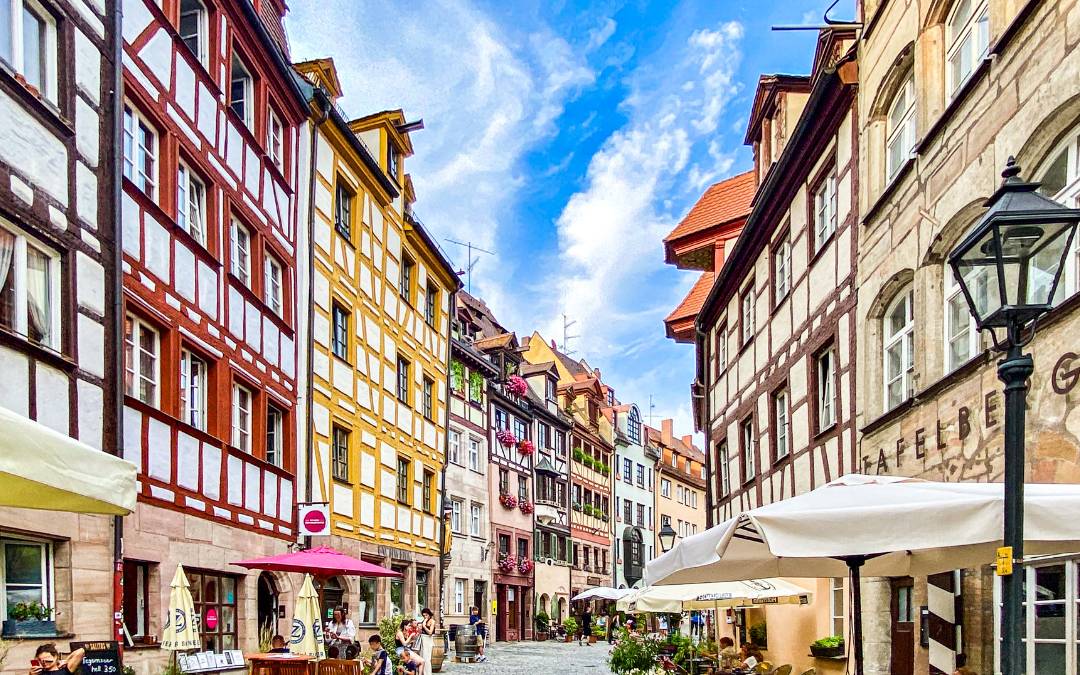
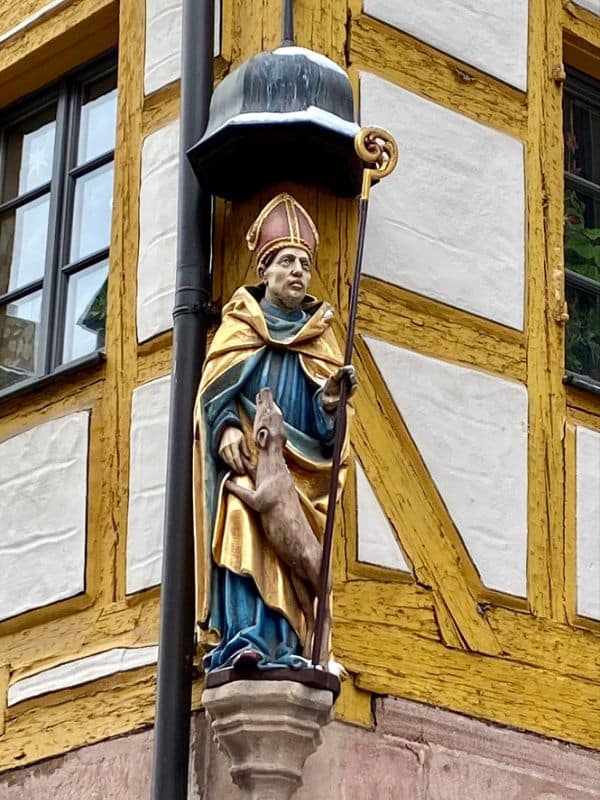
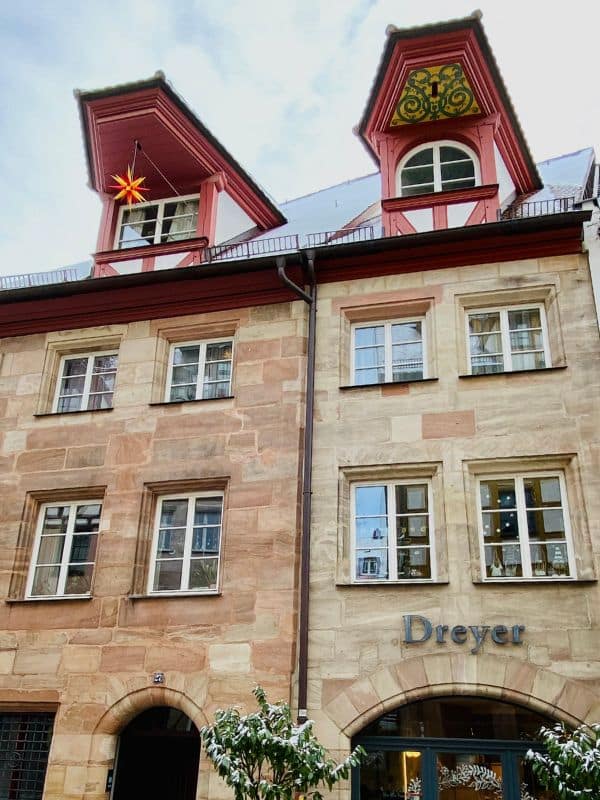
14. Handwerkerhof (Craftsmen's Yard)
The Handwerkerhof was created in 1971 on the occasion of Albrecht Dürer's 500th birthday as a tourist attraction in the former armory of the Kaiserburg wall. Located directly at the Königstor, opposite the main train station, this charming place offers an insight into traditional Nuremberg craftsmanship and medieval flair - even if it is itself a product of modern urban development.
Artisans showcase their skills in the small workshops and stores: From pewter casting and pottery to glass blowing, you can discover traditional techniques here. In the stores selling handmade jewelry, leather goods and typical Nuremberg gingerbread, you are sure to find a suitable souvenir.
With its half-timbered houses, cobblestones and rustic inns, the Handwerkerhof is reminiscent of old Nuremberg, making it a magnet for tourists from all over the world, who flock here from the train station towards the city center to treat themselves to their first bratwurst. On warm summer evenings, the Handwerkerhof is totally overcrowded, but on a snowy evening in the run-up to Christmas, I found it extremely picturesque.
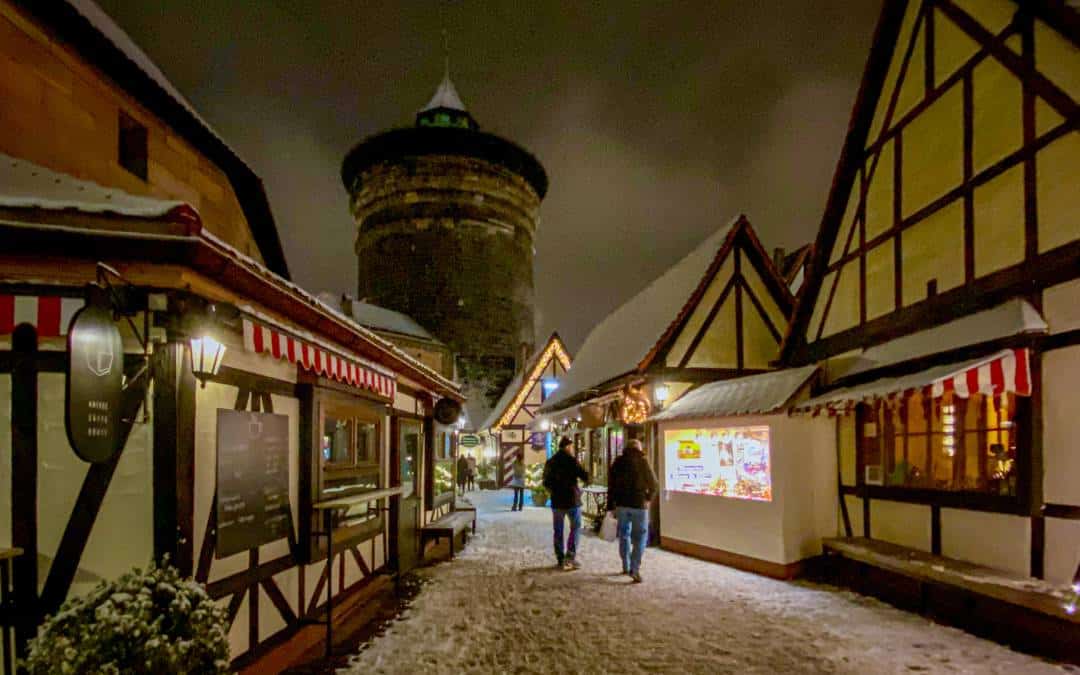
15. St. John's Cemetery
The St. John's Cemetery in the St. Johannis district, west of Nuremberg's city wall, is one of the most famous cemeteries in Europe and impresses with its special atmosphere, which is characterized by the artistically designed gravestones and the rich tradition of floral decorations. It was consecrated as early as 1395 and became the cemetery of Sebald's Old Town after burials were banned in Nuremberg's city center in 1518 due to the plague,
One of the most famous graves is that of Albrecht Dürer.whose gravestone is decorated with a simple inscription and a floral ornament. The resting place of Veit Stoß, the famous sculptor who created the Angel's Greeting in St. Lawrence Church, can be visited here. A walk through St. John's Cemetery is like a journey back in time to Nuremberg's past, as the gravestones tell stories of the craftsmen, merchants and artists who once shaped the city.
Particularly impressive is the splendour of the flowers tended by the relatives, which transform the cemetery into a sea of color in spring and summer. St. John's Cemetery is a cultural and historical gem that preserves Nuremberg's rich past in a quiet but impressive way.
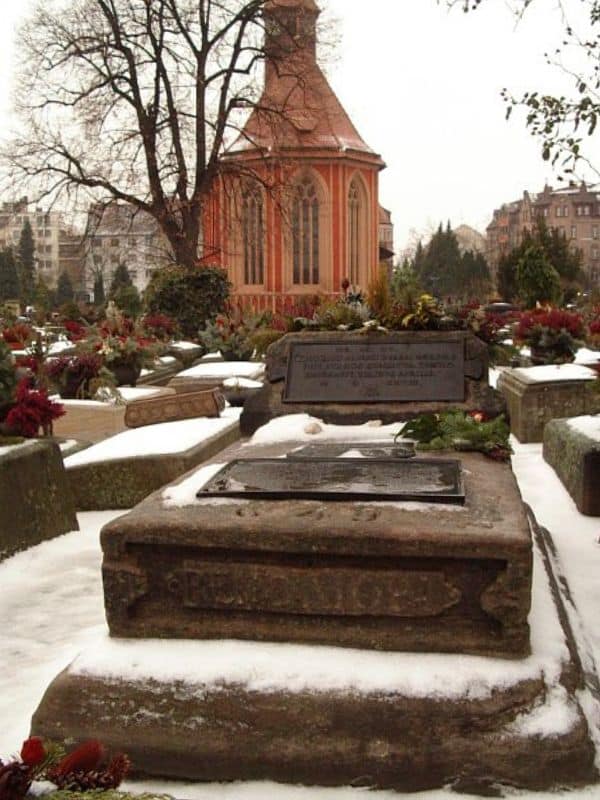
© Keichwa, CC BY 1.0, via Wikimedia Commons
St. John's Cemetery Info
Address: Brückenstraße 9, 90419 Nuremberg
Opening hours: April to September: 7 a.m. - 7 p.m., October to March: 8 a.m. - 5 p.m, December 6 to January 6: 8:00 am - 4:00 pm. You can find the current opening hours on the Vollmar-Akademie's website.
You can find more information about St. John's Cemetery on the Vollmar-Akademie's website.
16. Christmas Market
The Nuremberg Christmas Market is one of the oldest and most famous Christmas markets in the world - known for its rich history, the famous Nuremberg gingerbread and the iconic Christ Child. Since the 17th century, the market has constantly changed, experienced ups and downs, and was revived amidst the rubble after the Second World War. Today, the Nuremberg Christ Child, a young Nuremberg woman chosen by a jury, traditionally opens the market with a festive prologue in the gallery of the Frauenkirche.
The market stretches across the main market square and through almost the entire old town. In addition to the classic Christmas market, there is also the the Market of the Twin Cities, which offers international flair, as well as the Nuremberg Children's Christmas, which is a particular highlight for the little ones. You can find more details about the history and atmosphere of the Christkindlesmarkt in my article about the 30 most beautiful Christmas markets in Germany.
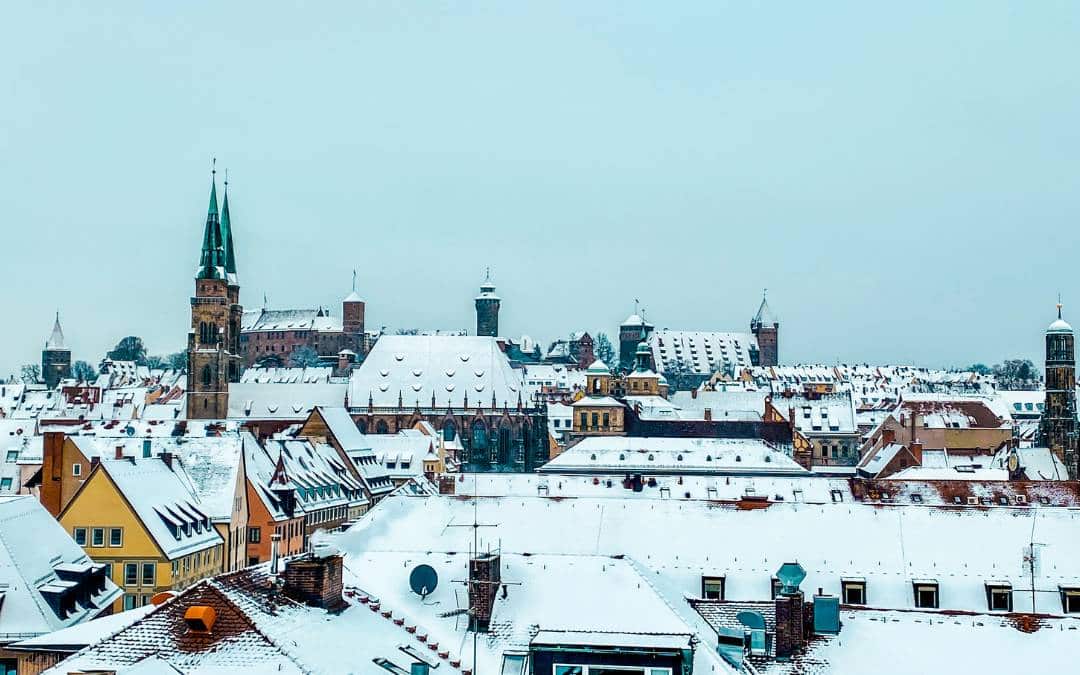
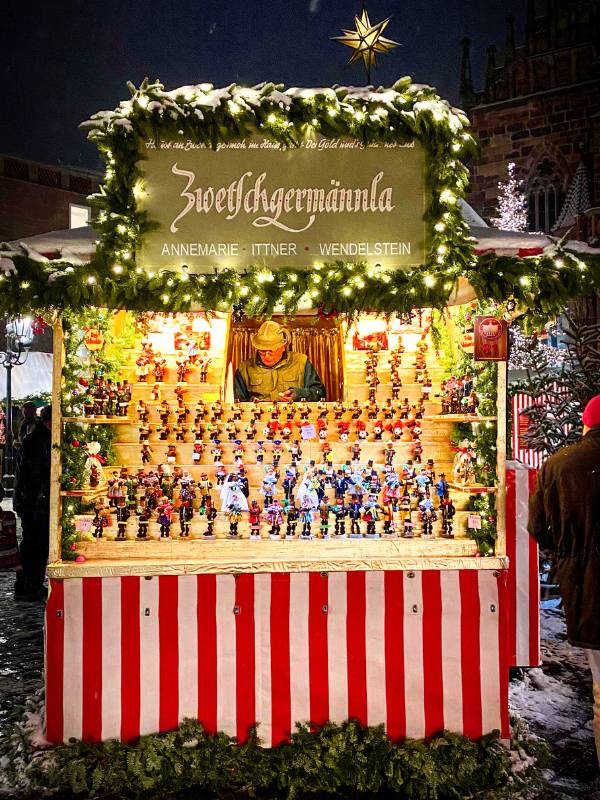
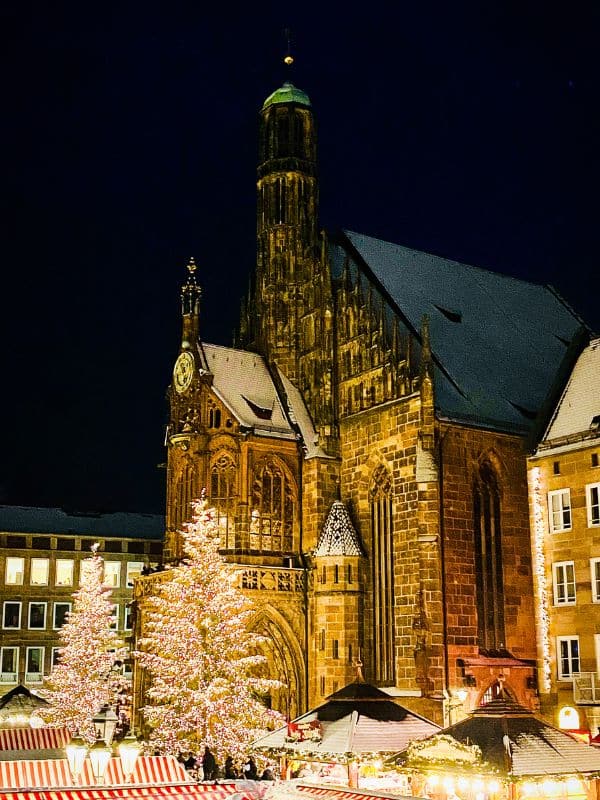
Interesting excursion destinations around Nuremberg
- Franconian Switzerland: This picturesque low mountain range is ideal for hikers, climbers and nature lovers. Visit romantic castles such as Pottenstein Castle, explore the Devil's Cave and enjoy the regional cuisine in one of the many brewery inns. As one of the largest cherry-growing regions in Germany, the region is also transformed into a magical sea of blossom in spring.
- Bamberg: The UNESCO World Heritage city impresses with its historic charm, the Old Town Hall in the middle of the river and the imposing cathedral. A stroll through "Little Venice" or a visit to one of the traditional smoked beer breweries is a must!
- Fürth: Only a few minutes away from Nuremberg, Fürth offers a charming old town with magnificent Wilhelminian-style buildings. Visit the Jewish Museum of Franconia or stroll along Gustavstrasse with its cozy cafés and restaurants.
- Rothenburg ob der Tauber: This medieval gem on the Romantic Road is about an hour's drive from Nuremberg and attracts visitors from all over the world with its cobbled streets, half-timbered houses and famous city wall. Perfect for a day trip.
- Regensburg: The UNESCO World Heritage city - one of the few German cities that was not destroyed in the Second World War - is just under an hour away from Nuremberg and is, in my opinion, one of the most beautiful cities in the country. The Stone Bridge, the cathedral and the historic old town offer impressive architecture and a rich history.
- Altmühl Valley: Idyllic river landscapes, castles and the spectacular Danube gorge near Kelheim make the Altmühltal Nature Park a beautiful vacation region that is perfect for hiking, cycling tours or a boat trip on the Altmühl.
- Ansbach: The charming residential city with its baroque palace, court garden and orangery is just under an hour away from Nuremberg. Take a stroll through the picturesque old town with its beautiful half-timbered houses.
How about a road trip through Bavaria?
Check out my article on the best road trip routes across the country you will find a suggestion for a great tour through Bavaria, on which you can discover many other highlights besides Nuremberg.
Practical Nuremberg tips
Stay overnight in Nuremberg - central, stylish and individual
Nuremberg's Old Town is one of the most beautiful in Germany: between the imposing Imperial Castle, the main market square and the historic craftsmen's courtyard, there is a piece of history on almost every corner. The distances are short and you can easily reach many sights on foot. And compared to other major cities, hotel prices here are often surprisingly moderate.
Three hotel recommendations for different budgets - all centrally located, well equipped and perfect for discovering Nuremberg on foot.
💰 Fair: Best Western Hotel Nuremberg at the main station*
Just a few minutes from the train station and a short walk to the Christmas market: this friendly hotel offers practical, cozy rooms and little extras such as free coffee and water. Ideal for an inexpensive short trip during Advent.
⭐️ Comfortable: Art & Business Hotel*
A real favorite hotel - with a stylish ambience, warm atmosphere and a great breakfast, which you can enjoy in the green courtyard in summer. The location is quiet but close to the city center: just a few steps from the train station and a short walk to the old town. You can easily park in the nearby station garage.
👑 Upscale: Hotel Drei Raben*
Individual, creative and with great attention to detail: this boutique hotel is located right at the entrance to the Old Town. Each room is dedicated to a Nuremberg legend and the service is personal and friendly. Anyone who values design and an exceptional overnight experience will feel particularly at home here.
Tips on recommended restaurants and cafés in Nuremberg
Nuremberg offers a diverse selection of restaurants and cafés, but they are often overcrowded, especially at weekends and during the Christmas market season. Reservations are therefore advisable. Here are my recommendations:
Air jumpThis charming café-restaurant in the old town combines modern cuisine with a cozy atmosphere. Perfect for breakfast, a short break with coffee and cake or a relaxed evening with creative dishes. I always felt at home here, even as a solo traveler.
Ca Castlefé BeerLocated right next to the Imperial Castle, this traditional Nuremberg café offers delicious homemade cakes and tarts. The ideal place for a relaxing break after a tour of the castle. Of course, you can also stock up on the finest Nuremberg gingerbread here. The main store is located at Breite Gasse 79.
Wirtshaus Hütt'n: Here, rustic coziness is a top priority. Hearty Franconian dishes and a large selection of beers make the Hütt'n a popular meeting place for locals and tourists alike.
Albrecht-Dürer-Stube: : A very nice, small, family-run restaurant serving typical Franconian cuisine with Dürer prints on the walls. The cozy atmosphere and lovingly prepared dishes make this restaurant a real insider tip.
Restaurant Heilig-Geist-Spital: Franconian specialties in a historic ambience directly on the Pegnitz. Here you can enjoy traditional dishes such as Schäufele or Nuremberg sausages.
Finca & Bar Celona: A successful blend of Mediterranean flair and relaxed atmosphere. Perfect for tapas, cocktails or a leisurely breakfast. The terrace right on the water is awesome!
vinegar sausage: Gourmet restaurant with innovative, sustainable cuisine in centuries-old walls. For special occasions.
Tips on How to Get to Nuremberg
By plane:
Nuremberg has its own airport, which is only around 7 km from the city center. From the airport, you can take the U2 subway line directly to Nuremberg Central Station in around 15 minutes - quick and easy.
Alternatively, you can use the airports Frankfurt/Main (230 km) or Munich (170 km). Both offer good train connections to Nuremberg. From Frankfurt Airport, the ICE takes you to Nuremberg in around 2.5 hours, from Munich you can be there in around 1 hour and 45 minutes.
By train:
Nuremberg Central Station is located directly on the edge of the Old Town and is a central transportation hub. Nuremberg is well connected to the German long-distance rail network, with numerous direct ICE and IC connections. The train is therefore an excellent choice for short trips or city tours.
By car:
Nuremberg is conveniently located near the highways A3, A6, A9 and A73which makes it easy to get here from all directions. There are numerous parking garages within the city, although they can be expensive, especially in the old town. If possible, park outside and use public transport to explore the city center.
Parking in Nuremberg
As in most large cities, free parking spaces are in short supply in Nuremberg city center. However, there are some options for paid parking as well as parking facilities slightly outside the city center, which are cheaper.
Central parking:
There are numerous parking garages in the old town, but they are quite expensive with daily fees of around €20 to €30. Particularly practical are the Parking garage Hauptmarkt, in the old town, as well as the Parking garage Sterntor near the main train station. If you have booked your hotel in the city center, many hotels offer their own parking facilities, but these are also subject to a charge.
Cheaper parking:
If you want to save a little, we recommend the Park + Ride system in Nuremberg. At several subway stations such as Messe or Langwasser Süd you can park your car for free or for a small fee and travel comfortably to the city center by public transport. Alternatively, the Parking garage at the Volksfestplatz an affordable daily rate (currently around €5), from where you can reach the old town in just a few minutes by streetcar.
You can find an overview of all parking options and tariffs at the Parking garage service Nuremberg. So you can choose the option that suits you best - central or price-conscious.
Planning a Self-Drive Tour in Germany?
Check out my article on the best road trip routes across the country for inspiration and practical tips.
Local Transport Tips
Nuremberg's Old Town and many of the most important sights are within easy walking distance. Nevertheless, public transport is worthwhile if you want to travel further distances or visit destinations outside the Old Town. Nuremberg has an excellent network of subway trains, streetcars and buses, which are operated by the VGN (Transport Association of Greater Nuremberg) is operated.
Particularly practical are the DayTickets:
- The DayTicket Solo for a single person costs € 9.10 (valid throughout the city).
- Worthwhile for groups or families DayTicket Pluswhich costs €13.50 for up to 6 people (max. 2 adults and up to 4 children under 18).
A one-way ticket within the city costs €3.20, while a short-distance ticket (up to 4 stops) is available for €1.90.
The subway is particularly efficient if you are traveling from the main station to destinations such as the Nuremberg Airport or the Documentation Center Nazi Party Rally Grounds want to reach. The streetcar lines are also ideal for a leisurely ride through the city.
Further information on timetables, fares and tickets can be found on the website of the VGN.
If you also want to visit museums, the Nuremberg Cardwhich includes public transportation.
Nuremberg Card
For all those who want to explore Nuremberg intensively, the Nuremberg Card an excellent choice. The card not only offers Free travel on all public transport in tariff zone A (Nuremberg, Fürth and Stein), but also free admission to over 30 museums and sights. These include highlights such as the Imperial Castle, the Documentation Center Nazi Party Rally Grounds, the Albrecht Dürer House and the Germanic National Museum.
The Nuremberg Card costs €33 for adults and €11 for children up to the age of 17. It is valid for two consecutive days and is therefore ideal for a weekend in the city. In addition to the main attractions, the card also allows you to use public transport to travel to more distant destinations such as the zoo or the airport.
The Nuremberg Card is available at tourist information offices, many hotels and online. It's perfect for anyone who doesn't want to worry about tickets and travel passes and wants to save money at the same time. An all-round carefree package for your visit to Nuremberg!
The most important questions about your short trip to Nuremberg
What must I definitely see in Nuremberg?
The Imperial Castle, the Albrecht Dürer House and the Frauenkirche on the main market square are definitely worth a visit. The Memorium Nuremberg Trials and the Documentation Center Nazi Party Rally Grounds offer deep insights into German Nazi history. For relaxation, take a walk through the Hesperides Gardens or the City park.
What festivals and events are there in Nuremberg?
In addition to the world-famous Christkindlesmarkt there is the Bard meetingan international music festival, and the Old Town Festival with Franconian cuisine and culture. With the Classical Open Air in Luitpoldhain, Nuremberg hosts the largest open-air classical music event on the European continent every year at the end of July/beginning of August.
How much time should I plan for Nuremberg?
For the most important sights you should at least two days plan in. If you want to visit the museums or explore the surrounding area, a stay of three to four days is worthwhile.
Where is Nuremberg located?
Nuremberg is located in Middle Franconia in the south of Germany, in the federal state of Bavaria. The city is located around 170 km north of Munich and is an important transportation hub.
How big is Nuremberg?
Nuremberg has around 540,000 inhabitants and is the second largest city in Bavaria after Munich. With an area of around 186 square kilometers, it is one of the largest cities in southern Germany.
Which important personalities have lived in Nuremberg?
Famous Nuremberg personalities are Albrecht Dürer.one of the most important artists of the Renaissance, and the sculptor Veit Stoß. Also Hans Sachsthe famous Meistersinger, the astronomer Regiomontanus and the philosopher Ludwig Feuerbach have lived and worked here.
Which typical Franconian specialties should you try in Nuremberg?
Highlights include the Nuremberg grilled sausagesserved with sauerkraut or potato salad. Also famous are the Nuremberg gingerbreadwhich are particularly popular at Christmas time, and Franconian Schäufele and Beer.
What can you do in Nuremberg when it rains?
Visit museumsThe Germanic National Museum houses an impressive collection on the cultural history of the German-speaking world, while the Neues Museum is the place to be for fans of modern art. In the Albrecht Dürer's House, you can explore the life and work of the famous artist.
Cinema experience in the CINECITTA‚The CINECITTA' multiplex cinema is one of the largest cinemas in Europe and offers a varied film program with state-of-the-art facilities. Here you can enjoy the latest blockbusters or arthouse films in comfortable auditoriums.
Discover historical sitesThe Memorium Nuremberg Trials in the Palace of Justice offers deep insights into post-war history and the important trials of Nazi war criminals.
Shopping and culinary delightsThe Imperial Road and Wide lane invite you to take a stroll. In the numerous cafés and restaurants, you can sample Franconian specialties and escape the rain.
Indoor activities: For a little more action, indoor offers such as Escape Rooms, Trampoline halls or Black light mini golfthat offer fun for young and old.
When does the Nuremberg Christmas Market take place?
The Christkindlesmarkt opens every year on the Friday before the first Advent and lasts until Christmas Eve. The Christ Child traditionally opens the market with a festive prologue in the gallery of the Frauenkirche.
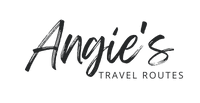
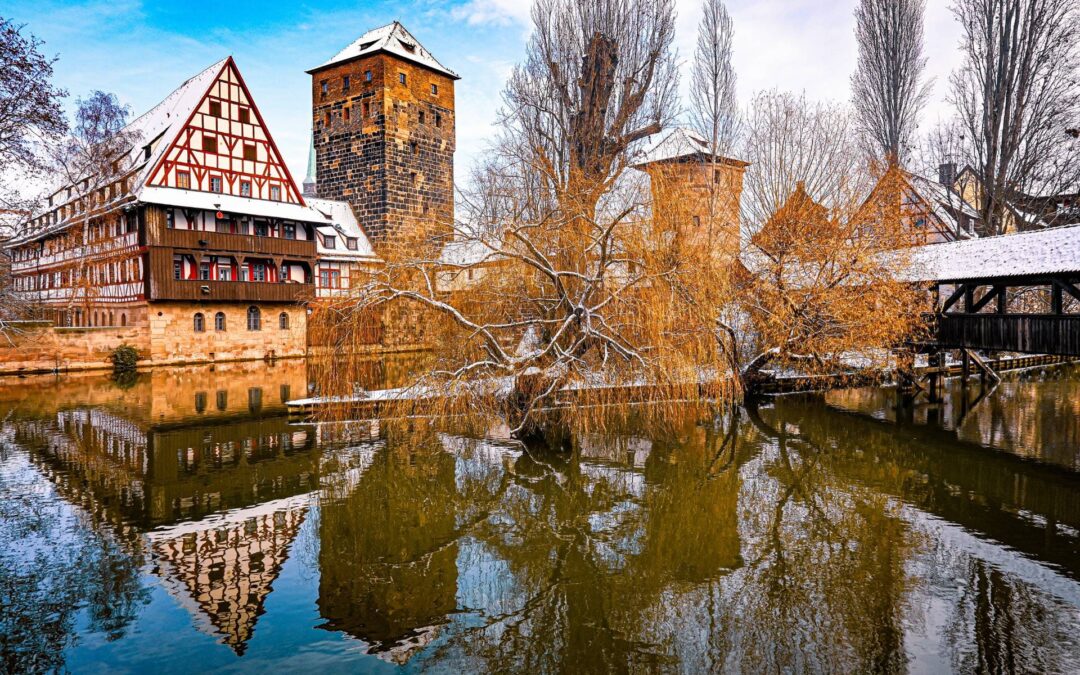


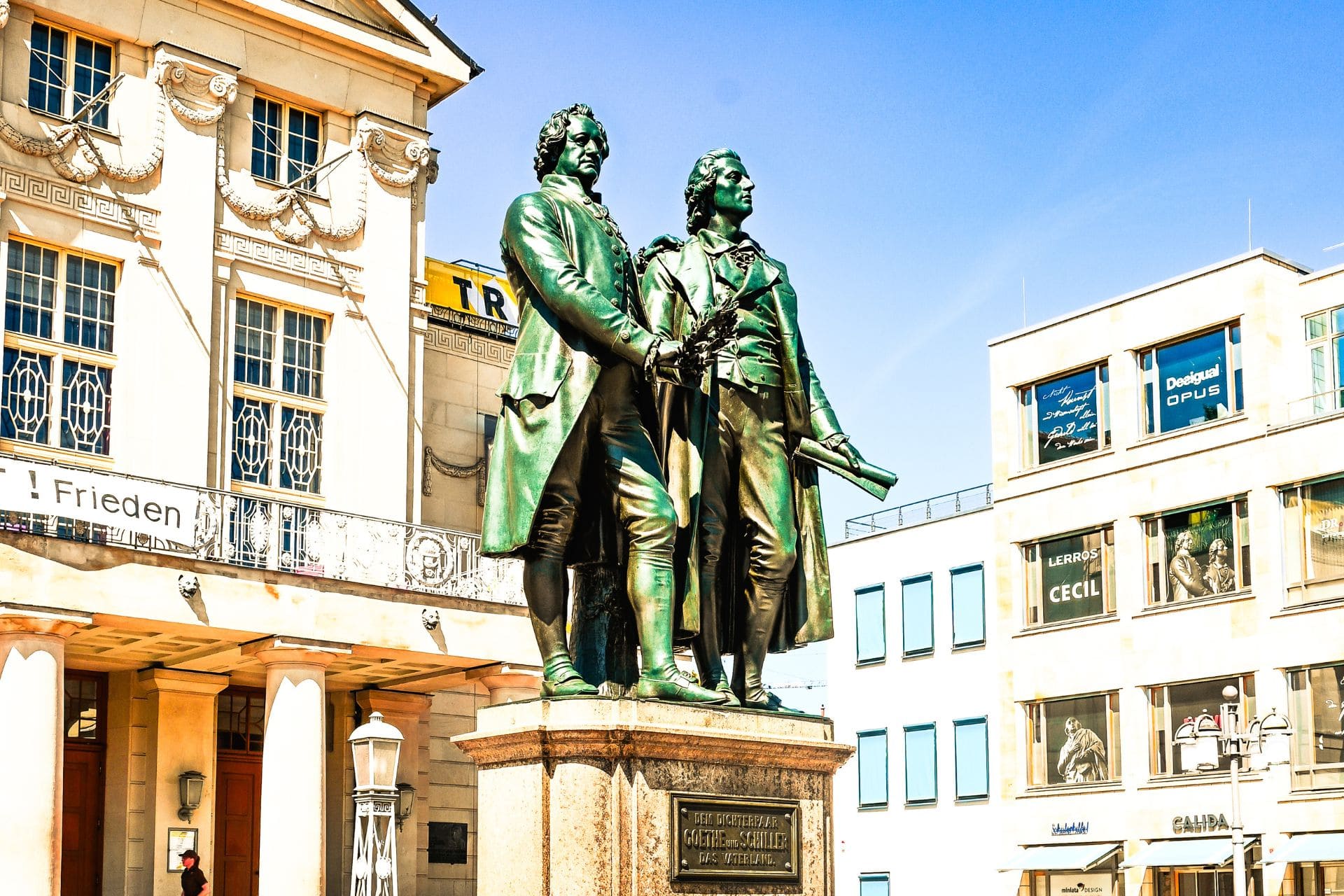

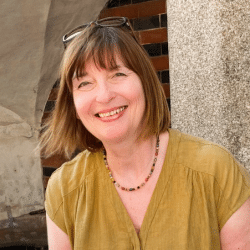
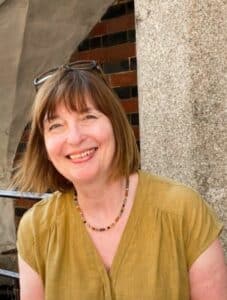
Dear Angie,
Nuremberg has been on my bucket list for Germany for ages. I'm using your beautiful photos and great travel tips as an opportunity to finally take a city trip there.
Warm regards,
Anja
Dear Anja,
Thank you very much for your nice comment! Nuremberg is an incredibly interesting city - especially for those interested in art and history. I'm sure you'll love it!
Warm regards
Angelika
Hello Angie! 😊
I absolutely loved your article about the sights in Nuremberg! I especially loved your section about the Imperial Castle - I love historic places with so much charm and history. 🏰 Your photos really convey the feeling of being right there. ❤️
I've never been to Nuremberg before, but now I really want to go there and discover the city with your tips! 😊 Thank you for also mentioning the lesser-known spots, that's what makes the article so special.
Do you have any tips for a particularly nice café or restaurant in Nuremberg that shouldn't be missed? ☕🍰
LG Rosi 🌸
Dear Roswitha,
I am very pleased about your positive feedback on my Nuremberg article. I have a separate section for restaurant and café tips under the sights. Hopefully you'll find it quickly using the table of contents. I liked Nuremberg so much that after my visit in summer 2022, I also went to the Christkindlesmarkt in the same year because the three days in summer were not enough to see all the sights that were important to me. It's really worth it!
Warm regards
Angelika